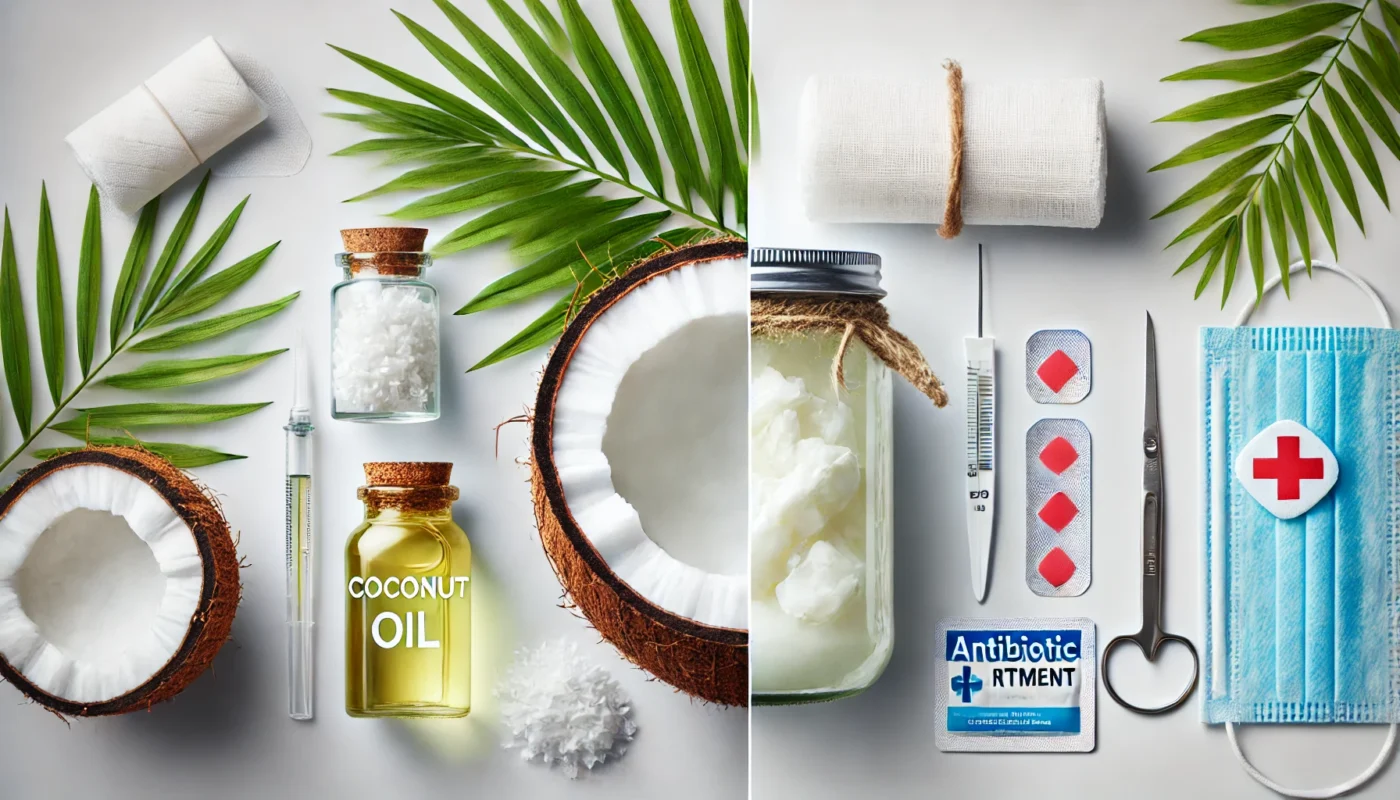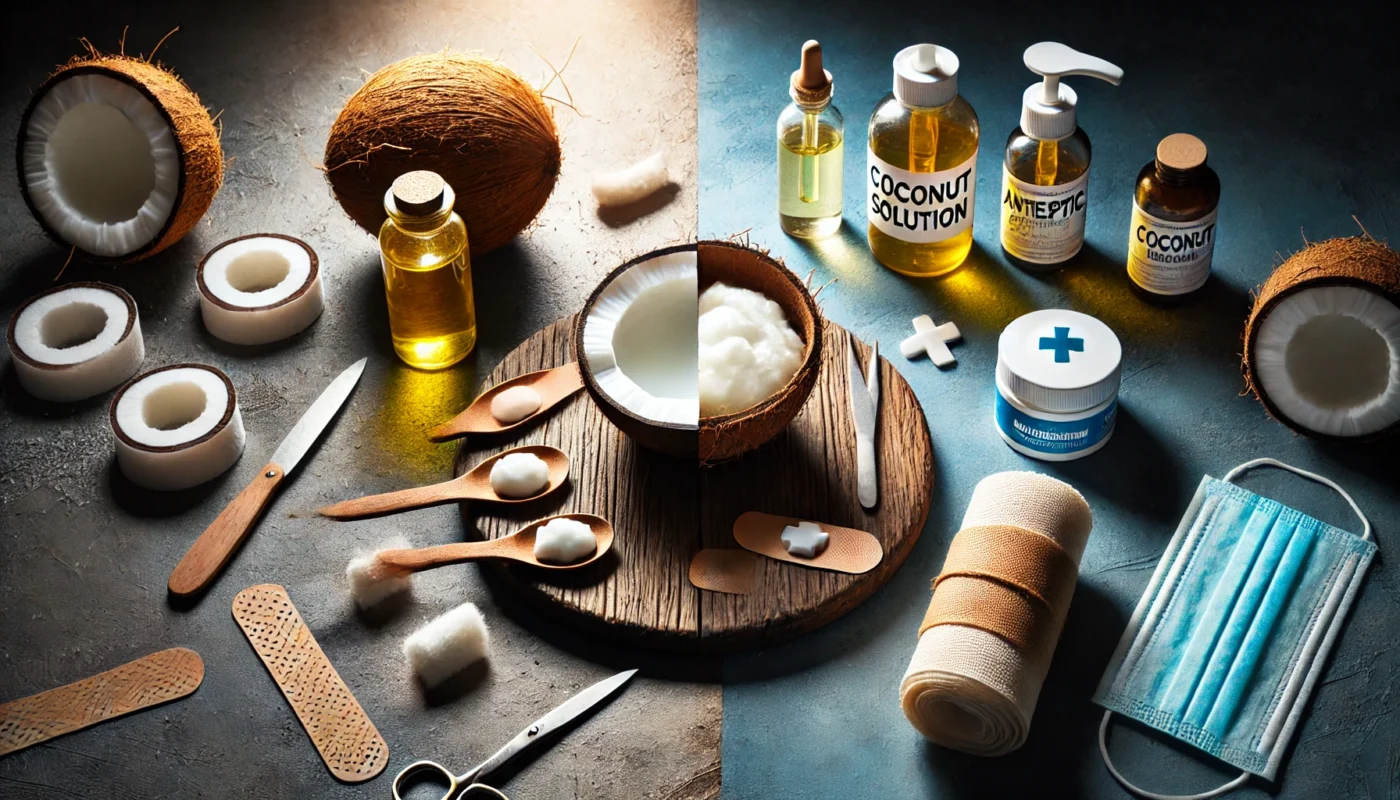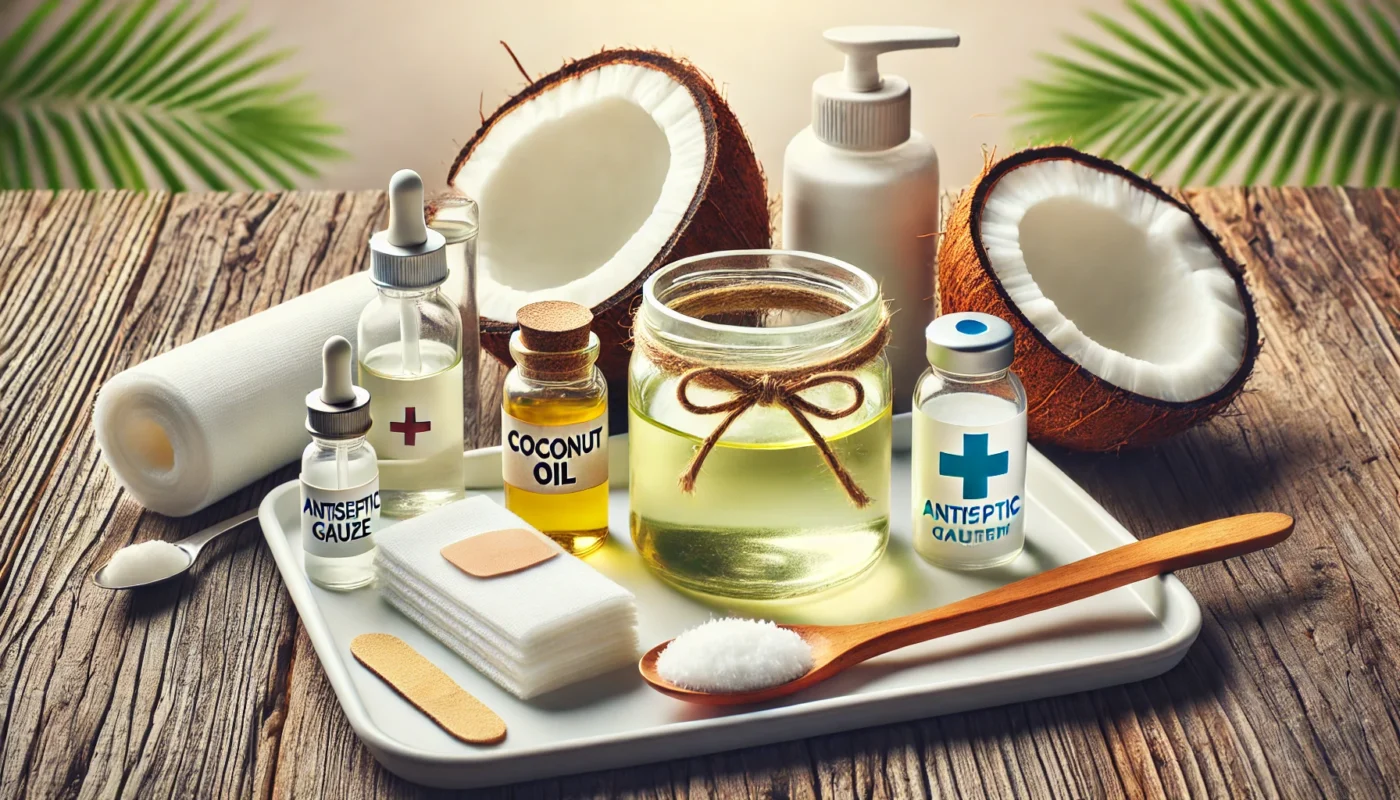Coconut oil is derived from the flesh of coconuts and is rich in medium-chain fatty acids, particularly lauric acid. These fatty acids are known for their antimicrobial, anti-inflammatory, and moisturizing properties, which contribute to coconut oil’s popularity in skincare.
You may also like: Home Remedies: Fight Cut Infections Naturally
Antimicrobial Properties
Lauric acid, the primary fatty acid in coconut oil, has demonstrated potent antimicrobial activity against a range of microorganisms, including bacteria, fungi, and viruses. This makes coconut oil a potential contender for preventing wound infections, which is crucial in the healing process. Studies have shown that lauric acid can disrupt the lipid membranes of harmful microorganisms, effectively neutralizing their threat to wound sites. Additionally, coconut oil’s ability to combat biofilms—complex communities of bacteria that are resistant to antibiotics—further underscores its potential in wound care.
Beyond its ability to combat infections, coconut oil can also play a role in managing microbial imbalances on the skin. This is particularly important for wounds as a balanced skin microbiome can significantly aid the healing process. By selectively targeting harmful microorganisms while leaving beneficial bacteria intact, coconut oil may promote a healthier wound environment conducive to recovery.
Anti-inflammatory Effects
Inflammation is a natural response to injury, but excessive inflammation can delay wound healing and increase the risk of complications. Coconut oil’s anti-inflammatory properties can help modulate this response, potentially speeding up recovery times and improving overall wound outcomes. The oil achieves this by inhibiting the production of inflammatory mediators, such as cytokines, which can exacerbate wound conditions if left unchecked.
Furthermore, coconut oil’s anti-inflammatory action may reduce pain and swelling around the wound site, providing relief and comfort to patients. By minimizing inflammation, coconut oil not only aids in faster healing but also decreases the likelihood of scarring, which is a common concern in wound management. Its ability to soothe and calm irritated skin makes it a valuable asset in the arsenal against prolonged inflammation.
Moisturizing Benefits
Keeping a wound moist is key to promoting optimal healing. Coconut oil is an excellent moisturizer that can prevent the wound from drying out, which can lead to scabbing and delayed healing. By maintaining a moist environment, coconut oil may support the regeneration of new tissue. This moisture retention can prevent the formation of hard scabs that may crack and reopen, thus hindering the healing process.
Moreover, coconut oil’s emollient properties help to soften the surrounding skin, reducing the risk of tears or secondary injuries that can occur in delicate areas. The oil’s ability to penetrate deeply ensures that even the underlying layers of skin receive adequate hydration, fostering an environment where cells can regenerate effectively. This continuous hydration can be particularly beneficial in chronic wounds, which often suffer from impaired moisture balance.

Coconut Oil in Wound Care
Given its promising properties, coconut oil has been used in various wound care applications, from minor cuts and scrapes to more severe injuries. However, it’s important to understand the appropriate use and limitations of coconut oil in wound care.
Application and Safety
When applying coconut oil to wounds, it is crucial to use a clean, sterile cotton swab or gauze to avoid introducing contaminants. Gently apply a thin layer of coconut oil to the affected area, ensuring complete coverage. For deeper wounds or surgical sites, consult a healthcare professional before using coconut oil, as it may not be suitable for all types of injuries. Ensuring that the application tools are sterile is vital to prevent the introduction of foreign bacteria into the wound.
Moreover, the frequency of application should be carefully monitored. Reapplying coconut oil too frequently can lead to skin maceration, where the skin becomes overly saturated and begins to break down. It’s advisable to follow a schedule that allows the wound to benefit from the oil’s properties while still having time to breathe and dry out slightly between applications.
Limitations and Considerations
While coconut oil has shown promise in wound care, it is not a cure-all. It may not be effective against all types of bacteria, and its efficacy can vary depending on the individual’s skin type and the nature of the wound. Additionally, individuals with coconut allergies or sensitivities should avoid using coconut oil. It’s important to conduct a patch test before widespread use to ensure no adverse reactions occur.
The stability of coconut oil at different temperatures should also be considered, as it may solidify in cooler environments, making it less practical for application. Furthermore, while coconut oil can complement traditional wound care methods, it should not replace them entirely, especially in more severe cases where medical intervention is necessary. Understanding these limitations can guide users in making informed decisions about its use in wound care.
Complementary Use with Other Treatments
Coconut oil can be used in conjunction with other wound care treatments to maximize healing benefits. For example, it can be applied after cleaning the wound with antiseptic solutions to provide moisture and antimicrobial protection. Combining it with other natural remedies, like honey or aloe vera, can enhance its efficacy, offering a broader spectrum of healing properties.
Additionally, using coconut oil alongside traditional dressings can provide dual benefits, allowing the wound to receive the structured protection of a bandage while enjoying the nourishing effects of the oil. It’s important, however, to coordinate these treatments with a healthcare professional to ensure they are complementary and not counterproductive. This holistic approach can offer a balanced strategy for wound management.

Traditional Wound Treatments
Traditional wound care typically involves cleaning the wound, applying an antiseptic, and covering it with a sterile bandage. These methods have been extensively researched and are considered the standard for wound management.
Antiseptics and Antibiotics
Traditional wound treatments often include the use of antiseptics and antibiotics to prevent infection. Products such as hydrogen peroxide, iodine, and antibiotic ointments are commonly used to kill bacteria and promote healing. These treatments are well-documented and offer a high level of protection against infections. Antiseptics work by directly killing pathogens on contact, whereas antibiotics can prevent bacterial growth, providing a multi-faceted approach to wound care.
Despite their efficacy, overuse of antibiotics can lead to resistance, a growing concern in healthcare. Therefore, it’s crucial to use these treatments judiciously, following medical advice closely. Understanding the specific needs of each wound can help determine whether an antiseptic or antibiotic is necessary, ensuring that treatments remain effective and sustainable over the long term.
Moist Wound Healing
Modern wound care emphasizes the importance of maintaining a moist environment to facilitate healing. This can be achieved with hydrocolloid dressings, hydrogels, and other moisture-retentive products. These treatments provide consistent moisture levels and are designed to optimize wound healing. Moist wound healing promotes cellular proliferation and migration, leading to faster tissue regeneration.
These advanced dressings offer additional benefits, such as absorbing excess exudate and reducing the risk of infection by creating a barrier to external contaminants. Their ability to adapt to the wound’s shape and size makes them versatile and effective across various wound types. By maintaining the right moisture balance, these treatments can significantly reduce healing time and improve overall outcomes.
Clinical Evidence
Traditional wound treatments are backed by extensive clinical research, providing a strong evidence base for their efficacy. Healthcare professionals rely on these treatments due to their proven track record in managing a wide range of wounds, from minor injuries to complex surgical sites. Clinical guidelines and protocols have been established based on years of research, offering a reliable framework for wound management.
The documented success of these treatments is reflected in their widespread use in hospitals and clinics worldwide. Studies continue to support their effectiveness, ensuring that healthcare providers have access to the best tools available for patient care. This robust evidence base provides confidence in traditional treatments, making them a trusted choice for many healthcare professionals.

Comparing Coconut Oil and Traditional Treatments
When it comes to wound care, choosing the right treatment depends on various factors, including the type and severity of the wound, individual preferences, and potential allergies or sensitivities. Here’s how coconut oil and traditional treatments compare:
Efficacy
Traditional treatments have a robust evidence base and are generally more effective for preventing infections and promoting healing in a wide range of wounds. Coconut oil, while promising, lacks extensive clinical research and may not be suitable for all wound types. Traditional methods offer a structured approach that has been refined over decades, ensuring consistency in results.
However, coconut oil’s natural properties can complement traditional treatments, providing additional benefits that support the healing process. For superficial wounds and in cases where patients prefer natural alternatives, coconut oil can serve as a supplementary option. Weighing the pros and cons of each method can help tailor wound care strategies to meet individual needs effectively.
Safety
Both coconut oil and traditional treatments can be safe when used appropriately. However, coconut oil may not be suitable for individuals with allergies, and improper application can introduce contaminants. Traditional treatments, on the other hand, are widely used and considered safe for most individuals. Their standardized formulations and application protocols ensure minimal risk when used correctly.
It’s important to consider individual health profiles and any pre-existing conditions that may affect treatment choices. Consulting with healthcare professionals can provide guidance on the safest and most effective options, ensuring that wound care is tailored to each patient’s unique circumstances.
Cost and Accessibility
Coconut oil is relatively inexpensive and widely available, making it an attractive option for those seeking a cost-effective alternative. Traditional treatments can vary in cost, with some advanced dressings and antiseptics being more expensive. However, the cost should be weighed against the benefits and potential outcomes of each treatment.
Accessibility is another crucial factor; while coconut oil can be found in most grocery stores, some traditional treatments may require prescriptions or be available only in medical settings. Considering both cost and accessibility can help patients make informed decisions about their wound care options, balancing affordability with quality and effectiveness.
Conclusion
Coconut oil offers a natural alternative for wound care with its antimicrobial, anti-inflammatory, and moisturizing properties. However, it is essential to weigh its benefits against traditional treatments, which provide a well-researched and effective approach to wound management. For minor cuts and scrapes, coconut oil can be a viable option, but for more severe or complex wounds, traditional treatments remain the gold standard. Always consult a healthcare professional to determine the best course of action for your specific wound care needs.
Ultimately, the choice between coconut oil and traditional treatments should be based on a comprehensive assessment of the wound, the patient’s preferences, and the available evidence supporting each option. By understanding the strengths and limitations of both approaches, individuals can make informed decisions that align with their health goals and enhance their healing journey.
Further Reading:
Should You Use Coconut Oil on Your Skin?
7 Times You Should NEVER Use Coconut Oil
Does coconut oil help scars heal?
wound care, coconut oil, traditional treatments, wound management, healing process, infection prevention, clinical evidence, safety, cost, accessibility, natural remedies, advanced dressings, healthcare professionals, patient care, wound types
Important Note: The information contained in this article is for general informational purposes only, and should not be construed as health or medical advice, nor is it intended to diagnose, prevent, treat, or cure any disease or health condition. Before embarking on any diet, fitness regimen, or program of nutritional supplementation, it is advisable to consult your healthcare professional in order to determine its safety and probable efficacy in terms of your individual state of health.
Regarding Nutritional Supplements Or Other Non-Prescription Health Products: If any nutritional supplements or other non-prescription health products are mentioned in the foregoing article, any claims or statements made about them have not been evaluated by the U.S. Food and Drug Administration, and such nutritional supplements or other health products are not intended to diagnose, treat, cure, or prevent any disease.

